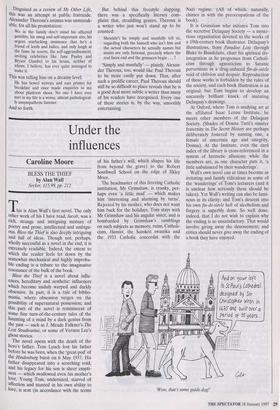Under the influences
Caroline Moore
BLESS THE THIEF by Alan Wall Secker, £15.99, pp. 212 This is Alan Wall's first novel. The only other work of his I have read, Jacob, was a rich, strange and intriguing mixture of poetry and prose, intellectual and ambigu- ous. Bless the Thief is also deeply intriguing and full of ideas. Though not, perhaps, wholly successful as a novel in the end, it is extremely readable. Indeed, the extent to which the reader feels let down by the somewhat mechanical and highly improba- ble ending is a tribute to the imaginative resonance of the bulk of the book.
Bless the Thief is a novel about influ- ences, hereditary and aesthetic: influences which become unduly warped and darkly obsessive. In part, it is a tale of biblio- mania, where obsession verges on the possibility of supernatural possession; and this part of the novel is reminiscent of some fine turn-of-the-century tales of the haunting of a mind by a dark genius from the past — such as J. Meade Falkner's The Lost Stradivarius, or some of Vernon Lee's ghost stories.
The novel opens with the death of the hero's father. Tom Lynch lost his father before he was born, when the 'great pod' of the Hindenburg burst on 6 May 1937. His father disappeared into a scorching void, and his legacy for his son is sheer empti- ness — which swallowed even his mother's love. Young Tom, undersized, starved of affection and stunted in his own ability to love, is sent (in accordance with the terms of his father's will, which shapes his life from beyond the grave) to the Robert Southwell School on the edge of Ilkley Moor.
The headmaster of this freezing Catholic institution, Mr Grimshaw, is cranky, per- haps even 'a little mad' — which makes him 'interesting and alarming by turns'. Rejected by his mother, who does not want him back for the holidays, Tom stays with Mr Grimshaw and his angular sister, and is bombarded by Grimshaw's ramblings on such subjects as memory, ruins, Catholi- cism, Hamlet, the Sanskrit swastika and the 1933 Catholic concordat with the Nazi regime. (All of which, naturally, chimes in with the preoccupations of the book).
It is Grimshaw who initiates Tom into the secretive Delaquay Society — a myste- rious organisation devoted to the works of a 19th-century book illustrator. Delaquay's illustrations, from Paradise Lost through Blake to Baudelaire, chart his spiritual dis- integration as he progresses from Catholi- cism through agnosticism to Satanic perversions in a drug-induced fin-de-siecle void of oblivion and despair. Reproduction of these works is forbidden by the rules of the society, and each book illustration is an original; but Tom begins to develop an uncannily brilliant knack of imitating Delaquay's drawings.
At Oxford, where Tom is studying art at the affiliated Isaac Lenau Institute, he meets other members of the Delaquay Society. (Shades of Donna Tartt's sinister fraternity in The Secret History are perhaps deliberately fostered by naming one, a female of uncertain age and integrity, Donna). At the institute, even the card index of the library is cross-referenced in a system of hermetic allusions; while the members are, as one character puts it, 'a little unbalanced by their wanderings'.
Wall's own novel can at times become as irritating and faintly ridiculous as some of the 'wanderings' of Tom's lecturers (and it is unclear how seriously these should be taken). Yet Wall's writing can also be lumi- nous in its clarity; and Tom's descent into his own fin-de-siecle hell of alcoholism and forgery is superbly done. So well done, indeed, that I do not wish to explain why the ending is so unsatisfactory. That would involve giving away the denouement; and critics should never give away the ending of a book they have enjoyed.
Wow, that's some guide dog!'


























































 Previous page
Previous page